第七章 换热网络合成ch72
- 格式:ppt
- 大小:350.00 KB
- 文档页数:35
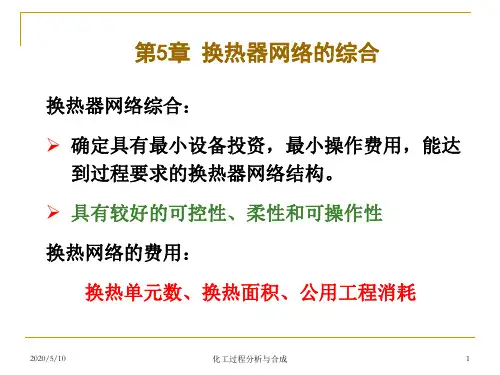

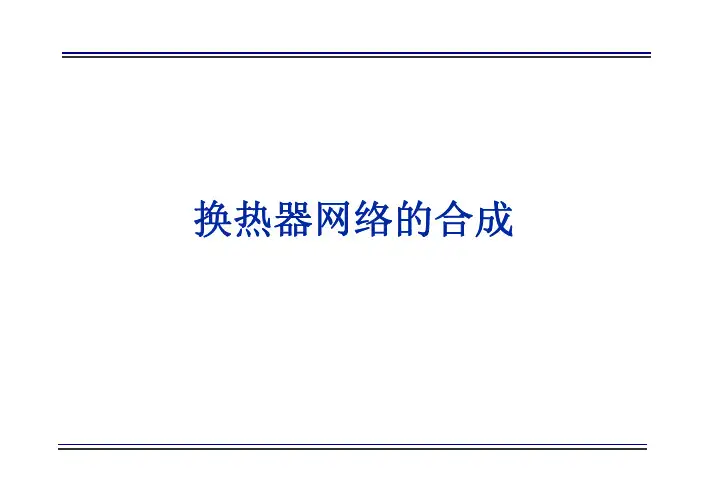
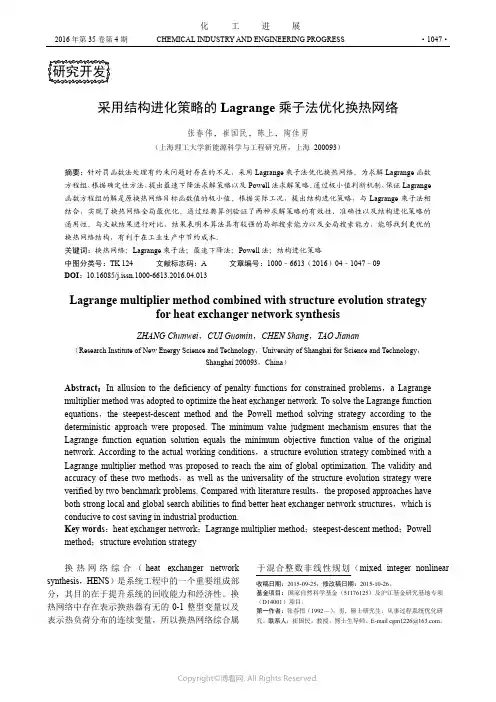
2016年第35卷第4期CHEMICAL INDUSTRY AND ENGINEERING PROGRESS ·1047·化工进展采用结构进化策略的Lagrange乘子法优化换热网络张春伟,崔国民,陈上,陶佳男(上海理工大学新能源科学与工程研究所,上海 200093)摘要:针对罚函数法处理有约束问题时存在的不足,采用Lagrange乘子法优化换热网络。
为求解Lagrange函数方程组,根据确定性方法,提出最速下降法求解策略以及Powell法求解策略。
通过极小值判断机制,保证Lagrange 函数方程组的解是原换热网络目标函数值的极小值。
根据实际工况,提出结构进化策略,与Lagrange乘子法相结合,实现了换热网络全局最优化。
通过经典算例验证了两种求解策略的有效性、准确性以及结构进化策略的通用性。
与文献结果进行对比,结果表明本算法具有较强的局部搜索能力以及全局搜索能力,能够找到更优的换热网络结构,有利于在工业生产中节约成本。
关键词:换热网络;Lagrange乘子法;最速下降法;Powell法;结构进化策略中图分类号:TK 124 文献标志码:A 文章编号:1000–6613(2016)04–1047–09DOI:10.16085/j.issn.1000-6613.2016.04.013Lagrange multiplier method combined with structure evolution strategyfor heat exchanger network synthesisZHANG Chunwei,CUI Guomin,CHEN Shang,TAO Jianan(Research Institute of New Energy Science and Technology,University of Shanghai for Science and Technology,Shanghai 200093,China)Abstract:In allusion to the deficiency of penalty functions for constrained problems,a Lagrange multiplier method was adopted to optimize the heat exchanger network. To solve the Lagrange function equations,the steepest-descent method and the Powell method solving strategy according to the deterministic approach were proposed. The minimum value judgment mechanism ensures that the Lagrange function equation solution equals the minimum objective function value of the original network. According to the actual working conditions,a structure evolution strategy combined with a Lagrange multiplier method was proposed to reach the aim of global optimization. The validity and accuracy of these two methods,as well as the universality of the structure evolution strategy were verified by two benchmark problems. Compared with literature results,the proposed approaches have both strong local and global search abilities to find better heat exchanger network structures,which is conducive to cost saving in industrial production.Key words:heat exchanger network;Lagrange multiplier method;steepest-descent method;Powell method;structure evolution strategy换热网络综合(heat exchanger network synthesis,HENS)是系统工程中的一个重要组成部分,其目的在于提升系统的回收能力和经济性。





(6)由于f(x2+4)>f(x2+3),则以反射点x2+3代替x h,得到新的单纯形x1=-3.5 6.625, x2=-4.5 5.375, x2+1=1.04.25 第五次迭代:(1)由于f g=f(x1)=11.89,f l=f(x2)=11.14,f h=f(x2+1)=25.3125,所以x h=x2+1=1.04.25, x g=x1=-3.5 6.625, x l=x2=-4.5 5.375 (2)检验。
由于f1<f(x*),不收敛。
(3)计算重心x2+2x2+2=12(x1+x2)=12-3.5-4.56.625+5.375=-4.0 6.0 (4)计算反射点x2+3=2x2+3-x h=-8.0 12.0-1.04.25=-9.0 7.75f(x2+3)=65.8125 (5)由于f(x2+3)大于f1和f g,说明需要压缩,计算压缩点x2+5x2+5=12x h+12x2+2=0.52.125+-2.0 3.0=-1.5 5.125 (6)由于f(x2+5)<f h,以x2+5代替x h,得到新的单纯形x1=-3.5 6.625, x2=-4.5 5.375, x2+1=-1.5 5.125⁝以上过程可以继续到f l值非常接近f(x*)为止。
从中可以看到,单纯形法的收敛速度确实非常缓慢。
3.6.4 化工实例———换热器网络的最优设计例:某化工厂欲利用本厂废热,采用3个换热器将某物料的温度由100℃加热到500℃,其流程和有关数据如图3-11所示。
问各温度如何选取才能使换热器系列的总传热面A为最小?已知条件为:(1)所有物流其F i c pi=105,其中F i是流体流量,c pi为流体比热容,i为流体序号,i=1,2,…。
(2)3个换热器的总传热系数分别为k1=120,k2=80,k3=40。
(3)为简化起见,换热器采用逆流换热时,其温差Δt m采用算术平均值。
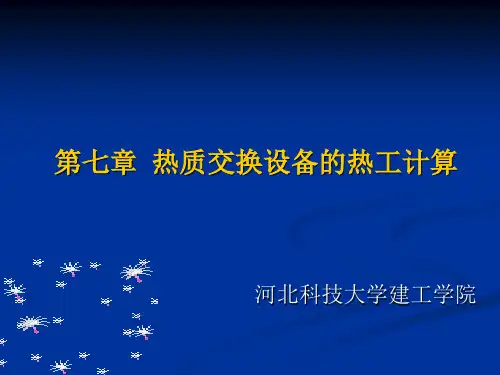
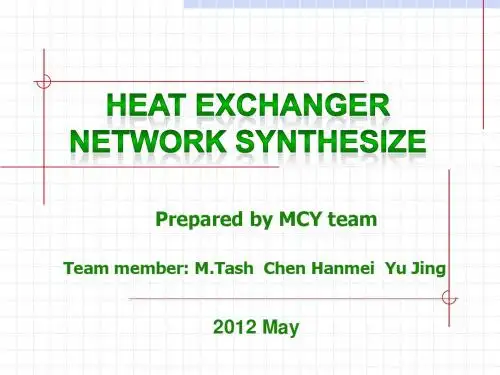
合成氢专业考试(试卷编号211)1.[单选题]氨冷却器是利用了冷冻循环的( )阶段A)压缩B)冷凝C)膨胀D)蒸发答案:D解析:2.[单选题]低温变换炉入口温度过高会使变换率( ).A)上升B)不变C)下降D)无法判断答案:C解析:3.[单选题]出洗涤塔工艺原料气温度偏高将会导致原料气( )增加。
A)带水B)带炭黑C)带二氧化碳D)带一氧化碳答案:A解析:4.[单选题]气体、液体的黏度随着温度的升高分别( ).A)增大、增大B)降低、增大C)增大、降低D)降低、降低答案:C解析:5.[单选题]甲醇洗汽提气使用的是( )氮气。
A)高压B)中压C)低压D)无要求6.[单选题]下列叙述错误的是( ).A)随着电子层数的增多,碱金属的原子半径逐渐增大B)碱金属具有强还原性,它们的离子具有强氧化性C)碱金属单质的熔点、沸点随着原子半径的增大而降低D)碱金属都是活泼金属,都易失去一个电子答案:B解析:7.[单选题]在相同反应温度下,加压汽化的氧油比常压汽化的( ).A)高B)低C)一样D)无法判断答案:B解析:8.[单选题]离心泵停车前应关闭( ).A)人口阀B)机封冲洗水阀C)泵体导淋阀D)出口阀答案:D解析:9.[单选题]装置停车前必须( ).A)切原料进气B)先降温C)先降压D)先编写好停车方案答案:D解析:10.[单选题]合成氨催化剂还原的原理是( ).A)3Fe2O3+CO=2FeO4+CO2+12.136kcal/kgB)3FeO3+H2=2Fe3O4+H0+2.298kcal/kgC)Fe3O4+H=3Fe+4HO-热D)5FeO4+32CO=3FeC2+26CO2答案:C解析:B)20MnMoC)1Cr18Ni9TiD)40Cr答案:C解析:12.[单选题]由Y型离心泵的型号250YS II-150错2可知该泵的吸入口直径是( )mm.A)300B)250C)150D)2答案:B解析:13.[单选题]离心泵启动前一般要求泵体的温度不得低于介质温度( )℃.A)40B)50C)60D)70答案:A解析:14.[单选题]建立压缩机密封油时,压缩机要( ).A)不带压B)停润滑油C)带一定压力D)已在运行中答案:C解析:15.[单选题]化工测量过程中测量参数( )的测量易引起纯滞后。
能源是国民经济持续健康发展的重要保障,在整个社会生产过程中,过程工业的能耗相当可观,而换热网络与公用工程系统又是过程工业的重要组成部分,其设计水平的高低对过程系统的能耗将有重要的影响。
换热网络优化就是试图以最经济的代价回收热量,降低过程系统的能耗,它密切结合我国当前的实际,具有重要的现实意义[1]。
1换热网络综合的目标换热器广泛地应用于过程工业中,生产实践中人们发现:虽然单个换热器的效率较高,但它进入一个大型换热网络之后换热的效率并不理想。
于是1965年Hwa在美国化学工程师协会上首次提出了换热网络的最优化问题[2]。
换热网络最优综合问题的简化描述就是要确定出具有较小或者最小的设备投资费用和操作费用,并满足把每个过程物流由初始温度加热或冷却到规定目标温度的换热网络。
其中设备投资费用主要与换热面积及换热设备台数有关,而操作费用主要与公用工程用量有关。
如果换热网络以换热网络的柔性、弹性、安全性、可操作性和可控制性等为定性目标,以最小年度费用为定量目标,最小年度费用包括设备投资费用和操作费用,设备投资费用主要与换热设备的换热面积、网络中换热器设备单元数及结构材料等有关,操作费用主要与公用工程负荷有关。
2换热网络综合的方法2.1夹点设计优化方法夹点技术(PinchTechnology)是以热力学为基础,从宏观的角度分析过程系统中能量沿温度的分布,从中发现制约系统用能的“瓶颈”,并给出解“瓶颈”的一种方法[3],它是在用启发试探法进行换热网络最优合成众多方法中最引人注目的一个。
1977年,Umeda等[4]基于热力学原理和概念,提出了利用T-H图综合网络的策略,并叙述了网络中温度夹点的存在。
1978年Linnhoff等[5]提出了夹点技术以来,换热网络综合有了突破性的进展,在学术和工程上的应用都取得了巨大的成就,其方法也在不断地完善和拓展。
Linnhoff和Ahmad[6]比较系统地论述了用于换热网络综合的夹点分析。
第六章换热器网络的综合换热器网络的综合的目标是,在公用工程用量最少的前提下,寻找设备投资最少(即换热单元数最少).实际上,这个目标很难同时满足,在实际进行网络设计时,一般是先找出最小公用工程消耗,然后再采取一定方法,减少换热单元数。
6。
1 热力学最小传热面积网络的综合根据有效能分析,在T-H图上合理分配传热温差及热负荷,实现冷热流体的逆流分配,得到满足要求的热力学最小面积网络。
具体步骤:①搜集物流数据:流量、温度、比热容、汽化热等;②构造冷、热物流的组合曲线;③调整冷热物流的组合曲线,使得最小传热温差不小于指定值;④划分温度间隔区间,进行物流匹配。
具体作法说明:例如,一换热器系统,包含两个热物流H1、H2和一个冷物流C1,经上述步骤一、二、三后,在T—H图上得到的结果如图6-1所示。
线段AE、FD、GH分别表示物流H2、H1、C1,热物流的组合曲线为ABCD,物流间的最大换热量为Q R,所需的最小公用工程冷却负荷为Q C,min,所需的最小公共工程加热负荷为Q H,min。
图6-1 确定物流间的最大换热量按照第四步,进行组合曲线区间的分割,由热物流组合曲线的折点B和C,分别引垂线交冷物流线段GH于点I和P,则表面冷物流C1的IP段要同热物流H1的CF线段进行匹配热物流H2的BE部分匹配换热,为此,要把冷物流的IP段要分解为两股物流,分割结果见图6—2。
图6—2 分割区间确定匹配关系图6-3 对应图6—2的换热网络换热网络合成的研究(1)Hohmann的开创性工作。
提出了换热网络最少换热单元数的计算公式,在温焓图上进行过程物流的热复合,找到了换热网络的能量最优解,即最小公用消耗,从理论上导出了换热网络的两个理想状态,从而为换热网络设计指明了方向。
(2)Linnhoff和Flower的工作从热力学的角度出发,划分温度区间和进行热平衡计算,这样可通过简单的代数运算就能找到能量最优解(即最小公用工程消耗),这就是著名的温度区间法(简称TI法).工业换热器网络的设计,大都以总的年费用最小为目标。